Peracetylated 4-fluoro-glucosamine reduces the content and repertoire of N- and O-glycans without direct incorporation
- PMID: 21493714
- PMCID: PMC3122228
- DOI: 10.1074/jbc.M110.194597
Peracetylated 4-fluoro-glucosamine reduces the content and repertoire of N- and O-glycans without direct incorporation
Abstract
Prior studies have shown that treatment with the peracetylated 4-fluorinated analog of glucosamine (4-F-GlcNAc) elicits anti-skin inflammatory activity by ablating N-acetyllactosamine (LacNAc), sialyl Lewis X (sLe(X)), and related lectin ligands on effector leukocytes. Based on anti-sLe(X) antibody and lectin probing experiments on 4-F-GlcNAc-treated leukocytes, it was hypothesized that 4-F-GlcNAc inhibited sLe(X) formation by incorporating into LacNAc and blocking the addition of galactose or fucose at the carbon 4-position of 4-F-GlcNAc. To test this hypothesis, we determined whether 4-F-GlcNAc is directly incorporated into N- and O-glycans released from 4-F-GlcNAc-treated human sLe(X) (+) T cells and leukemic KG1a cells. At concentrations that abrogated galectin-1 (Gal-1) ligand and E-selectin ligand expression and related LacNAc and sLe(X) structures, MALDI-TOF and MALDI-TOF/TOF mass spectrometry analyses showed that 4-F-GlcNAc 1) reduced content and structural diversity of tri- and tetra-antennary N-glycans and of O-glycans, 2) increased biantennary N-glycans, and 3) reduced LacNAc and sLe(X) on N-glycans and on core 2 O-glycans. Moreover, MALDI-TOF MS did not reveal any m/z ratios relating to the presence of fluorine atoms, indicating that 4-F-GlcNAc did not incorporate into glycans. Further analysis showed that 4-F-GlcNAc treatment had minimal effect on expression of 1200 glycome-related genes and did not alter the activity of LacNAc-synthesizing enzymes. However, 4-F-GlcNAc dramatically reduced intracellular levels of uridine diphosphate-N-acetylglucosamine (UDP-GlcNAc), a key precursor of LacNAc synthesis. These data show that Gal-1 and E-selectin ligand reduction by 4-F-GlcNAc is not caused by direct 4-F-GlcNAc glycan incorporation and consequent chain termination but rather by interference with UDP-GlcNAc synthesis.
Figures
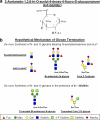
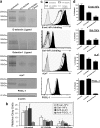
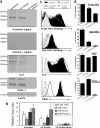
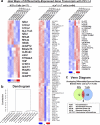
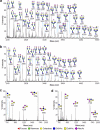


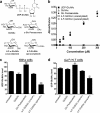
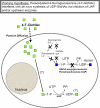
Similar articles
-
Helicobacter pylori β1,3-N-acetylglucosaminyltransferase for versatile synthesis of type 1 and type 2 poly-LacNAcs on N-linked, O-linked and I-antigen glycans.Glycobiology. 2012 Nov;22(11):1453-64. doi: 10.1093/glycob/cws101. Epub 2012 Jul 11. Glycobiology. 2012. PMID: 22786570 Free PMC article.
-
Ameliorating skin-homing receptors on malignant T cells with a fluorosugar analog of N-acetylglucosamine: P-selectin ligand is a more sensitive target than E-selectin ligand.J Invest Dermatol. 2006 Sep;126(9):2065-73. doi: 10.1038/sj.jid.5700364. Epub 2006 May 11. J Invest Dermatol. 2006. PMID: 16691194
-
Synthesis of a new nanomolar saccharide inhibitor of lymphocyte adhesion: different polylactosamine backbones present multiple sialyl Lewis x determinants to L-selectin in high-affinity mode.Glycobiology. 1997 Jun;7(4):453-61. doi: 10.1093/glycob/7.4.453-c. Glycobiology. 1997. PMID: 9184825
-
Chemoenzymatic Synthesis of Tri-antennary N-Glycans Terminating in Sialyl-Lewisx Reveals the Importance of Glycan Complexity for Influenza A Virus Receptor Binding.Chemistry. 2024 Jun 6;30(32):e202401108. doi: 10.1002/chem.202401108. Epub 2024 May 8. Chemistry. 2024. PMID: 38567703 Free PMC article.
-
Mouse Siglec-F and human Siglec-8 are functionally convergent paralogs that are selectively expressed on eosinophils and recognize 6'-sulfo-sialyl Lewis X as a preferred glycan ligand.Glycobiology. 2005 Nov;15(11):1125-35. doi: 10.1093/glycob/cwi097. Epub 2005 Jun 22. Glycobiology. 2005. PMID: 15972893
Cited by
-
Synthesis and in vitro cytotoxicity of acetylated 3-fluoro, 4-fluoro and 3,4-difluoro analogs of D-glucosamine and D-galactosamine.Beilstein J Org Chem. 2016 Apr 20;12:750-9. doi: 10.3762/bjoc.12.75. eCollection 2016. Beilstein J Org Chem. 2016. PMID: 27340467 Free PMC article.
-
Base-modified UDP-sugars reduce cell surface levels of P-selectin glycoprotein 1 (PSGL-1) on IL-1β-stimulated human monocytes.Glycobiology. 2016 Oct;26(10):1059-1071. doi: 10.1093/glycob/cww053. Epub 2016 May 27. Glycobiology. 2016. PMID: 27233805 Free PMC article.
-
Decoding Strategies to Evade Immunoregulators Galectin-1, -3, and -9 and Their Ligands as Novel Therapeutics in Cancer Immunotherapy.Int J Mol Sci. 2022 Dec 8;23(24):15554. doi: 10.3390/ijms232415554. Int J Mol Sci. 2022. PMID: 36555198 Free PMC article. Review.
-
Targeting the Chondroitin Sulfate Proteoglycans: Evaluating Fluorinated Glucosamines and Xylosides in Screens Pertinent to Multiple Sclerosis.ACS Cent Sci. 2019 Jul 24;5(7):1223-1234. doi: 10.1021/acscentsci.9b00327. Epub 2019 May 30. ACS Cent Sci. 2019. PMID: 31404231 Free PMC article.
-
Fluorosugar chain termination agents as probes of the sequence specificity of a carbohydrate polymerase.J Am Chem Soc. 2012 Apr 18;134(15):6552-5. doi: 10.1021/ja301723p. Epub 2012 Apr 10. J Am Chem Soc. 2012. PMID: 22458542 Free PMC article.
References
-
- Liu F. T., Rabinovich G. A. (2010) Ann. N.Y. Acad. Sci. 1183, 158–182 - PubMed
-
- Rabinovich G. A., Ilarregui J. M. (2009) Immunol. Rev. 230, 144–159 - PubMed
-
- Rabinovich G. A., Toscano M. A. (2009) Nat. Rev. Immunol. 9, 338–352 - PubMed
-
- Salatino M., Croci D. O., Bianco G. A., Ilarregui J. M., Toscano M. A., Rabinovich G. A. (2008) Expert Opin. Biol. Ther. 8, 45–57 - PubMed
-
- Ley K., Kansas G. S. (2004) Nat. Rev. Immunol. 4, 325–335 - PubMed
Publication types
MeSH terms
Substances
Grants and funding
LinkOut - more resources
Full Text Sources
Other Literature Sources
Research Materials

